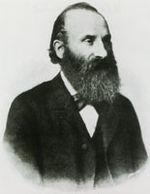
Heinrich Koebner
Encyclopedia

He studied medicine in Berlin
Berlin
Berlin is the capital city of Germany and is one of the 16 states of Germany. With a population of 3.45 million people, Berlin is Germany's largest city. It is the second most populous city proper and the seventh most populous urban area in the European Union...
, earning his doctorate in 1859 at Breslau. Afterwards he performed hospital duties in Vienna
Vienna
Vienna is the capital and largest city of the Republic of Austria and one of the nine states of Austria. Vienna is Austria's primary city, with a population of about 1.723 million , and is by far the largest city in Austria, as well as its cultural, economic, and political centre...
under Ferdinand von Hebra (1816-1880) and in Paris
Paris
Paris is the capital and largest city in France, situated on the river Seine, in northern France, at the heart of the Île-de-France region...
with Alfred Hardy (1811-1893). In 1876 he became director of the policlinic for syphilis
Syphilis
Syphilis is a sexually transmitted infection caused by the spirochete bacterium Treponema pallidum subspecies pallidum. The primary route of transmission is through sexual contact; however, it may also be transmitted from mother to fetus during pregnancy or at birth, resulting in congenital syphilis...
and diseases of the skin at the University of Breslau. In 1884 he established a new policlinic in Berlin, where he provided classes for physicians.
Koebner was a renowned dermatologist known for his research of psoriasis
Psoriasis
Psoriasis is an autoimmune disease that appears on the skin. It occurs when the immune system mistakes the skin cells as a pathogen, and sends out faulty signals that speed up the growth cycle of skin cells. Psoriasis is not contagious. However, psoriasis has been linked to an increased risk of...
, epidermolysis bullosa simplex
Epidermolysis bullosa simplex
Epidermolysis bullosa simplex is a disorder resulting from mutations in the genes encoding keratin 5 or keratin 14.Blister formation of EBS occurs at the dermoepidermal junction. Sometimes EBS is called epidermolytic.-Subtypes:...
and various fungal
Fungus
A fungus is a member of a large group of eukaryotic organisms that includes microorganisms such as yeasts and molds , as well as the more familiar mushrooms. These organisms are classified as a kingdom, Fungi, which is separate from plants, animals, and bacteria...
disorders. He is best-known for the eponymous Koebner phenomenon
Koebner Phenomenon
The Koebner phenomenon, also called the "Koebner response" or the "isomorphic response", refers to skin lesions appearing on lines of trauma. The Koebner phenomenon may result from either a linear exposure or irritation...
, also known as isomorphic phenomenon. The Koebner phenomenon is the development of isomorphic pathologic
Pathology
Pathology is the precise study and diagnosis of disease. The word pathology is from Ancient Greek , pathos, "feeling, suffering"; and , -logia, "the study of". Pathologization, to pathologize, refers to the process of defining a condition or behavior as pathological, e.g. pathological gambling....
lesion
Lesion
A lesion is any abnormality in the tissue of an organism , usually caused by disease or trauma. Lesion is derived from the Latin word laesio which means injury.- Types :...
s in the traumatized "uninvolved skin" of persons who have cutaneous diseases such as psoriasis. In other words, if a person has psoriasis, an injury is followed by new psoriatic lesions on the injured but otherwise normal (formerly non-psoriatic) skin, and these new lesions are similar to those of the diseased (originally psoriatic) skin in a clinical and histopathological
Histopathology
Histopathology refers to the microscopic examination of tissue in order to study the manifestations of disease...
sense.
In 1872, Koebner explained this phenomenon to the Silesian Society for National Culture, by presenting a case in which years after the appearance of an isolated plaque
Plaque
Plaque or placque may refer to:* Commemorative plaque, a flat ornamental plate or tablet fixed to a wall, used to mark a significant event, person, etc.* Memorial Plaque, issued to next-of-kin of dead British military personnel after World War I...
of psoriasis, several "traumatic" events in remote areas of the body (tattoos, animal bite, suppuration from lymphadenitis, et al.), caused outbreaks of psoriasis in the patient at exactly the same location, in the shape of the injured skin. "Koebnerization" may also occur with skin disorders such as vitiligo
Vitiligo
Vitiligo is a condition that causes depigmentation of sections of skin. It occurs when melanocytes, the cells responsible for skin pigmentation, die or are unable to function. The cause of vitiligo is unknown, but research suggests that it may arise from autoimmune, genetic, oxidative stress,...
and lichen planus
Lichen planus
Lichen planus is a chronic mucocutaneous disease that affects the skin, tongue, and oral mucosa. The disease presents itself in the form of papules, lesions, or rashes. Lichen planus does not involve lichens, the fungus/algae symbionts that often grow on tree trunks; the name refers to the dry and...
. The following terms are derived from Koebner's name, and are still used by modern dermatologists.
- koebnerization: word to describe the isomorphic process taking place
- reverse koebnerization: is seen when an area of psoriasis clears; an isomorphic nonresponse.
- pseudo-koebnerization: is used to describe the spread of an infectious agent such as warts and molluscum contagiosumMolluscum contagiosumMolluscum contagiosum is a viral infection of the skin or occasionally of the mucous membranes. It is caused by a DNA poxvirus called the molluscum contagiosum virus . MCV has no animal reservoir, infecting only humans. There are four types of MCV, MCV-1 to -4; MCV-1 is the most prevalent and...
.

